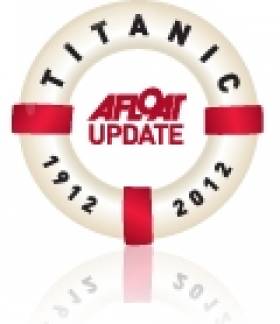Displaying items by tag: Titanic Memorial Cruise
Royal Navy Attend Presidential Fleet Review for Cobh Titanic 100
#COBH TITANIC 100 - Following President Michael D. Higgins visit to Cobh to commemorate the centenary call of RMS Titanic to Queenstown, the town yesterday hosted a Naval Service review that included the Royal Navy's HMS Mersey.
The President as supreme commander of the Defence Forces boarded the Naval Service 'flagship' L.E. Eithne which passed the guest-ship, a River class patrol vessel which headed a line of vessels which lay at anchor of Cobh's waterfront, they were the L.E. Aoife, L.E. Aisling and L.E. Niamh
The historic event which marked the pinnacle of the Titanic 100 Cobh centenary week will continue as part of a year-round programme of events. For information visit www.titanic100.ie. On the homepage the L.E. Niamh features again, where on this occasion marine photographer Jehan Ashmore captured the vessel underway as she powered her way at high-speed through a misty Dalkey Sound.
Among the many places throughout Cobh where thousands of tourists have flocked since the Balmoral docked on Monday to retrace the liner's maiden voyage, has been the White Star Line pier.
From this pier were the last passengers to depart Queenstown on board the tenders PS Ireland and PS America to the ill-fated Titanic that struck an ice-berg. On her Irish call 123 passengers were transferred to the Titanic which lay outside Cork Harbour, while 7 passengers disembarked from the liner and headed ashore.
What remains of the pier which is not accessible to the public and is in danger of collapsing, there has been calls to raise funds to save the structure, as previously reported.
Also in attendance during yesterday's historic proceedings, was the excursion passenger tender Spirit if the Isles which is operating on her second season since starting Cork Harbour cruises last year. They run between Cork city quays and downriver along the Lee to Cobh.
In the 1980's the tender then named Ingot ran excursions from Dun Laoghaire Harbour into Dublin Bay and likewise of L.E. Niamh, she too transited Dalkey Sound as part of her sightseeing tours.
- RMS Titanic
- White Star Line
- Cobh Cruise Callers
- Cobh, Cork Harbour
- Cruiseships
- Balmoral
- FredOlsen Cruise Lines
- Titanic Memorial Cruise
- naval service
- LEEithne
- Royal Navy
- HMS Mersey
- President Michael D Higgins
- Queenstown,Ireland
- PS Ireland
- PS America
- Spirit of the Isles
- Cork Harbour Cruises
- Cork Harbour News
- Dalkey Sound
- LE Niamh
- LE Aoife
- LE Aisling
- Cork Harbour
- River Class Patrol vessels
- River Lee
- Irish marine photographers
Titanic Memorial Cruise Heads for Cobh
#TITANIC MEMORIAL CRUISE - Following Balmoral's recent call to Belfast in memory of Titanic, the Fred.Olsen Lines cruiseship returned to Southampton where today she started a 12-night Titanic Memorial Cruise which will follow the White Star Line liner's original itinerary that included calling to Queenstown, now Cobh.
Before Balmoral calls to Cobh tomorrow, she is to pass Cherbourg, where the passenger tender SS Nomadic served the liner that layed anchored offshore. The 101 year-old tender was also built by Harlalnd & Wolff and she is undergoing restoration work in Belfast, to read more about her click HERE.
Likewise to Balmoral's Belfast visit, her arrival to Cobh is the inaugural call for this year's season, though her poignant arrival will be two days short of Titanic's call a century ago on 11th April 1912.
On Titanic's second anchorage at Queenstown, this too required tenders to transfer 123 passengers who embarked from the town's pier and of those only 44 survived the disaster. The timber built pier still exists albeit what survives is in a derelict state. There have been calls to raise funds to save the structure as previously reported.
Along the scenic waterfront passengers can take a tour of the town's new Titanic Experience in the White Star Line building, the Queenstown Heritage Story in the Cobh Hertiage Centre and the walking Titanic Trails.
From Cobh the Balmoral will sail across the Atlantic, arriving at the Titanic site on April 14th/15th - exactly 100 years on from this tragic voyage, where a memorial service will be held to pay tribute to the brave passengers and crew who perished on that fateful night.
The cruise will then continue to Halifax, Nova Scotia, the final resting place of many who were on board, before sailing on to New York, the Titanic's ultimate planned destination.
- White Star Line
- RMS Titanic
- Balmoral
- Fred Olsen Cruise Lines
- Titanic Memorial Cruise
- Cobh Cruise Calls 2012
- Belfast Port
- SS Nomadic
- Titanic's passenger tender
- Cruise ship news
- Cruiseships
- port of Cork
- Cobh Cruise Terminal
- Titanic Trails
- Cobh Heritage Centre
- White Star Line liners
- Queenstown,Ireland
- Harland & Wolff
- Nomadic Charitble Trust































































